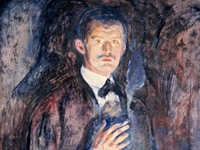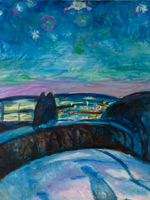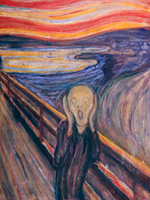ART ON BOARD  The Munch Museum has curated a thematic scheme specifically for our ocean ships to showcase several pieces of art per day: MONDAY Dedicated to showing Munch’s many self-portraits TUESDAY Reserved for the display of Munch’s most famous works WEDNESDAY AND THURSDAY Selected to celebrate the lighter side of Munch’s work with motifs focused on gardens, animals and architecture FRIDAY Allocated to Munch’s more dramatic work SATURDAY Dedicated to our guests, with themes related to oceans and travel SUNDAY Devoted to calmer scenes, such as landscapes |
 MUNCH MOMENTS
MUNCH MOMENTSThrough an exclusive relationship with Oslo’s Munch Museum, Viking has been granted the digital rights to the entire collection of Norway’s most famous artist, Edvard Munch. Our “Munch Moments” bring the magic of Munch to our ocean ships with a daily, interactive event that provides an opportunity for guests to learn about his extraordinary life and work.
Each afternoon, the ship’s magnificent three-deck Atrium is transformed into an interactive event of art and music. Select famous artworks are projected onto the wall of the main stairs, accompanied by evocative Norwegian compositions that reflect the different moods and themes expressed through about 50 Munch works in all.
WHO WAS MUNCH
Edvard Munch (1863–1944) was a Norwegian expressionist painter and printmaker, and is recognized today as perhaps one of the world’s most famous artists. Munch began to paint early at the age of 12 and lived a life devoted to art. His artistic oeuvre extends over a period of more than 60 years, during which he painted more than 2,000 paintings and made tens of thousands of prints.
Munch can be said to be almost as famous for his life as he is for his art. In periods, he lived a nomadic and turbulent bohemian life, together with the Kristiania Bohemians in the Norwegian capital and with the group around the wine bar Zum schwarzen Ferkel in Berlin. During his long life as an artist, Munch experimented with the different painterly directions of his time, but it is first and foremost as a symbolist and expressionist he has become famous. Paintings such as The Scream, Madonna, Death in the Sickroom and The Dance of Life are highly praised icons in art history.
 EMOTION UNCOVERED
EMOTION UNCOVEREDMunch’s most famous painting, The Scream, exists in four versions. He created this masterpiece in 1893, and the onboard painting is a later version from 1910. The motif is inspired by an experience Munch describes in a poem in his diary in 1892. “I was walking along the road with two friends—the sun was setting—suddenly the sky turned blood red—I paused, feeling exhausted, and leaned on the fence—there was blood and tongues of fire above the blue-black fjord and the city—my friends walked on, and I stood there trembling with anxiety—and I sensed an infinite scream passing through nature.” The same swirling brush strokes are used in a 1894 bare-torso Madonna, an oil on canvas piece.
There are many coastal pictures on display painted from Munch’s property overlooking the Norweigan fjords. It has been said that he often asked his coachman to halt at the plateau above his vacation home to admire the view there of the Oslofjord. He liked to stand at his easel in wind and weather and paint nature scenes by the fjord in all seasons. When Munch moved back to his hometown in 1909, the pessimistic undertone that had become prominent in much of his earlier works faded quite a bit, and he took more of a colorful, playful approach with his paintings. This is clear in his later works.
